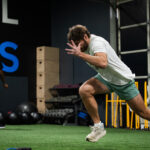Speed Training for Soccer: Position-Specific Drills
In soccer, speed isn’t one-size-fits-all. A winger’s sprint pattern differs from a center back’s. That’s why position-specific speed training for soccer can take your performance from average to elite.
This guide breaks down the speed demands of each position and shows you how to train accordingly.
Why Tailor Speed Training to Position?
Every soccer position requires speed—but in different forms:
-
Forwards need acceleration and agility to break past defenders
-
Midfielders need endurance and quick transitions
-
Defenders need lateral movement and recovery speed
-
Goalkeepers need explosive short bursts
Tailoring speed drills to match your role improves match-day performance and reduces injury risk.
The NSCA emphasizes sport-specific conditioning as the key to better energy system use, reaction times, and speed endurance.
Speed Training for Forwards
Forwards rely on quick starts, sharp cuts, and explosive finishing runs.
Drills for Forwards:
-
Sprint + Finish Drill
Sprint 20 yards toward goal, receive a pass, and shoot in stride.
Focus: Timing your sprint with a shot. -
Cone Zig-Zag + Burst
Weave through 5 cones, then explode into a 10-yard sprint.
Focus: Change of direction followed by max speed. -
Reactive Breakaway Sprints
Start stationary. Sprint on cue into a breakaway run.
Focus: Reaction and timing your acceleration.
Speed Training for Midfielders
Midfielders cover the most ground. They need quick reactions, controlled sprints, and the ability to change pace.
Drills for Midfielders:
-
Box-to-Box Intervals
Sprint from penalty box to penalty box (55 yards), jog back.
Focus: Speed endurance. -
360° Cone Drill
Place cones in a circle. Sprint to a random cone on cue.
Focus: Reaction and agility. -
Transition Sprint Drill
Sprint 10 yards forward, backpedal 5, then sprint 10 again.
Focus: Transition movement patterns.
Speed Training for Defenders
Defenders need lateral speed, recovery sprinting, and fast direction changes.
Drills for Defenders:
-
Mirror Shuffle + Sprint
Partner drill: shuffle laterally to mirror your partner, then sprint on cue.
Focus: Reaction and lateral movement. -
Backpedal + Sprint Drill
Start in a backpedal, then explode into a sprint.
Focus: Defensive recovery runs. -
1v1 Reaction Sprint
Face an attacker. React to their movement and sprint to cut them off.
Focus: Game-like defensive speed.
Speed Training for Goalkeepers
Goalkeepers may move less overall but need extreme explosiveness in tight spaces.
Drills for Goalkeepers:
-
Lateral Cone Hops + Dive
Hop side to side over cones, then dive to save.
Focus: Lateral explosiveness and reaction. -
Quick Feet Ladder + Sprint
Footwork through agility ladder, followed by 5-yard sprint to collect a ball.
Focus: Foot speed and short burst. -
Reaction Ball Toss
Have a coach bounce a ball in front. React and dive quickly.
Focus: Reflex and reaction speed.
Sample Weekly Speed Plan by Position
Each session should last 30–45 minutes with full recovery between sprints.
Forwards (2x/week)
-
Sprint + Finish
-
Zig-Zag Cone Run
-
Breakaway Sprints
-
Core & glute strength
Midfielders (2x/week)
-
Box-to-Box Runs
-
360° Cone Drill
-
Transition Sprints
-
Mobility + stretch
Defenders (2x/week)
-
Mirror Shuffle
-
Backpedal Sprints
-
1v1 Defending
-
Lateral strength
Goalkeepers (2x/week)
-
Lateral Hops
-
Quick Feet Ladder
-
Dive Drills
-
Core & reaction work
All players benefit from general strength and mobility training too. Explore full programs at Next Level Athletics USA.
Training Tips by Position
Forwards
-
Time runs to avoid offsides
-
Practice sprinting while watching the ball
Midfielders
-
Train in varied directions and durations
-
Use small-sided games for endurance
Defenders
-
Stay low for lateral quickness
-
Train short, explosive first steps
Goalkeepers
-
Focus on footwork between saves
-
Use reaction lights or tools for fun reflex work
Custom speed training pays off when it reflects the realities of your role.
Conclusion: Play Faster Where It Matters
Speed is essential in soccer—but how you train for it should reflect your position. Tailoring your speed training for soccer to your role ensures you move with more purpose, react faster, and perform better.
Whether you’re attacking, defending, or stopping goals, there’s a drill that fits your needs. Commit to your specific role, train smart, and take your game to the next level.


Recent Comments